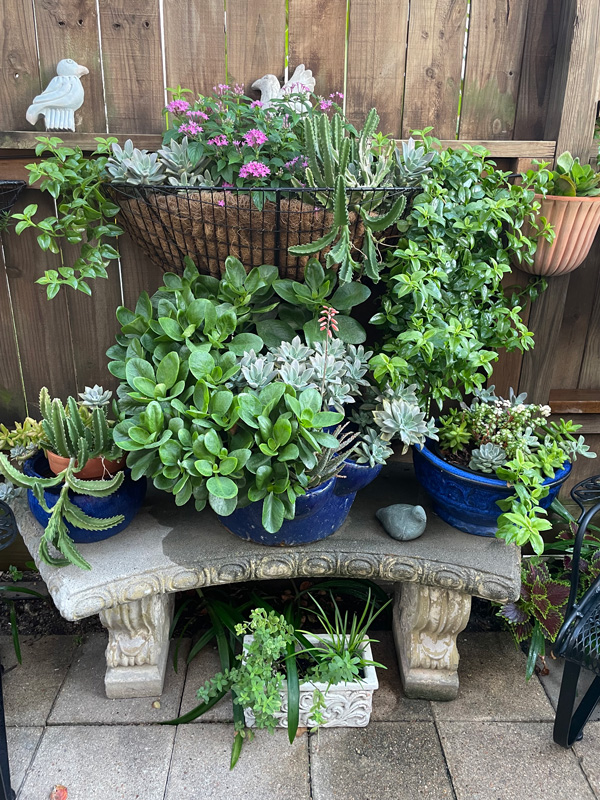Seashells by the seashore . . . and so much more – By Diane Morey Sitton

Some of the first things you notice about Carol and Hank Cornelius’s garden are the seashells. They fill baskets, they outline paths, and they decorate the fence.
But the captivating shells are only one highlight among many in this small island retreat.

Nestled in Galveston’s East End Historic District, the relatively new garden melds family treasures, alley finds, repurposed items, and an assortment of urns and statuary collected from antique shops and estate sales with a medley of plants including ferns, succulents, annuals, perennials and bulbs.
“When we bought the house four years ago, the garden consisted of grass and grass burrs,” says Hank.
Today, a conversation area adorned with seashell-filled baskets and antique, cone-shaped wall planters is the first thing you see as you step through the side-street gate into the L-shaped back garden.

Some of the seashells in the baskets came from Carol’s grandmother’s collection.
“My grandmother got me interested in shells when I was a child,” says Carol. “She volunteered by teaching craft classes to WWII veterans. She used seashells in her classes.”
The wall planters came from an estate sale.
“They were in disrepair when we got them,” says Carol.
Now filled with pentas, ice plant, hens and chicks, kalanchoe, sedum and starfish plant, they overhang three large, succulent-filled pots that sit on a concrete bench.
Just ahead, in the border by the fence, four crape myrtles provide shade, privacy and seasonal color. A chartreuse iron bench, a wrought iron headboard attached to the fence, a wistful cherub, and two black, oyster shell-embellished orbs displayed atop urns complete the setting.
“I like whimsy, or ‘folly’ as it was called in the Victorian era,” confesses Carol, a retired art teacher whose lessons were often based on repurposing found items into art. “I’ve used that look to decorate the garden.”
Other backyard highlights include a dining area that’s adjacent to a wooden platform built to raise the air conditioning units out of harm’s way in the event of salt water flooding. Staghorn ferns, potted caladiums, and cast iron plants thrive in the shady, grotto-like compartment under the platform. Wind chimes and stained glass hang from the ceiling. A small leaf-shaped pool sits on the floor.

“The largest staghorn fern is 20 years old,” says Carol. “It belonged to my Dad.”
Another niche garden flourishes under an outdoor staircase. Plants here include caladiums, bromeliad and oxalis.

Colorful pollinator plants and flowering bulbs enliven the front garden, a pair of small, newly designed and built courtyards that flank the front entrance staircase. The gardens were inspired by courtyards in Savannah, Georgia, and Charleston, South Carolina. One side is dedicated to dining and conversation: the other side focuses on attracting bees and butterflies.
“We change the plants in the pollinator garden each season,” says Hank. “In summer we grow zinnia, moss rose, blue daze, and several colors of pentas.”
Bulb-type plants passed along from family add seasonal color and interest along the front fence. The iris and spider lilies came from Hank’s grandfather’s house near Waco. Many of the amaryllis came from Carol’s grandfather’s garden, via Carol’s parent’s garden.
In contrast to the reds, yellows, pinks and other vibrant colors of the pollinator courtyard, the natural finishes of repurposed items set the mood in the dining courtyard. Here, an alley-find urn serves as a fountain, rusty headboards function as trellises, and discarded fence pickets create a rustic tabletop.
In keeping with the natural patina of the fountain, bench and urns found in the courtyards, the paving is salt finished concrete.
“The salt finish creates shallow indentations on the concrete, making it look like sandstone,” explains Hank.
It’s not surprising that the flowers and natural finishes of the front “conversation areas” create an inviting atmosphere.
“The front courtyards are my favorite part of the garden,” says Hank. “We like to relax there at dusk. Neighbors are out walking. It’s a time to visit and enjoy the twilight.”
Special thanks to Carol Cornelius for sharing photos of her garden.



